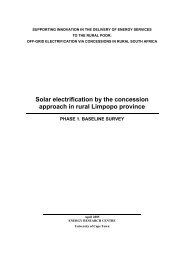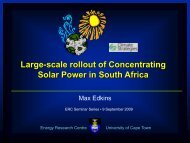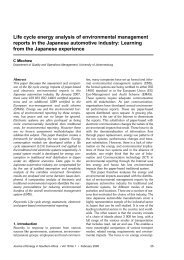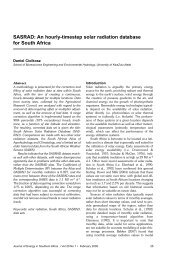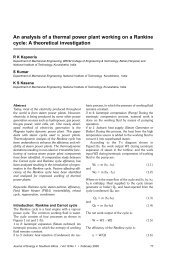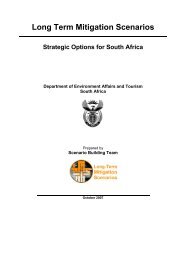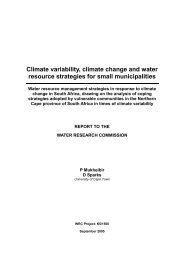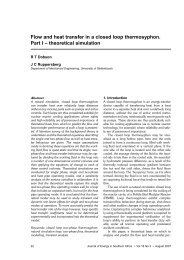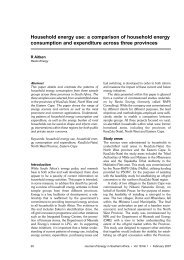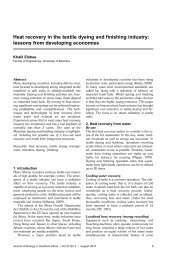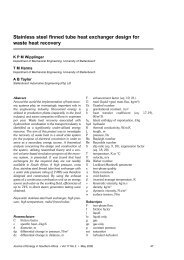(Ed) 2006. Energy policies for sustainable development in South Africa
(Ed) 2006. Energy policies for sustainable development in South Africa
(Ed) 2006. Energy policies for sustainable development in South Africa
Create successful ePaper yourself
Turn your PDF publications into a flip-book with our unique Google optimized e-Paper software.
ENERGY POLICIES FOR SUSTAINABLE DEVELOPMENT IN SOUTH AFRICA: EXECUTIVE SUMMARY<br />
In Chapter 6, which exam<strong>in</strong>es the economic po<strong>in</strong>t of view, the build<strong>in</strong>g of local<br />
manufactur<strong>in</strong>g capacity <strong>for</strong> added-value <strong>in</strong>dustries is identified as a way of chang<strong>in</strong>g<br />
exist<strong>in</strong>g patterns of <strong>in</strong>vestment <strong>in</strong> sectors that see their competitive advantage <strong>in</strong> cheap<br />
electricity. Changes <strong>in</strong> energy pric<strong>in</strong>g deserve more attention <strong>in</strong> this regard. Overall, the<br />
issue of energy security and its relation to diversity of supply has implications <strong>for</strong> the<br />
economy as a whole. Another economic dimension concerns job losses <strong>in</strong> the coal m<strong>in</strong><strong>in</strong>g<br />
and electricity sectors, which raises the need to identify new areas where jobs can be<br />
created <strong>in</strong> energy supply – or <strong>in</strong>deed <strong>in</strong> promot<strong>in</strong>g the more efficient use of energy.<br />
Part II: Scenarios of future energy <strong>policies</strong> and <strong>in</strong>dicators of <strong>susta<strong>in</strong>able</strong><br />
<strong>development</strong><br />
Part II presents possible energy futures <strong>for</strong> <strong>South</strong> <strong>Africa</strong> and demonstrates how <strong>in</strong>dicators of<br />
<strong>susta<strong>in</strong>able</strong> <strong>development</strong> can be used to assess options. A range of energy <strong>policies</strong> <strong>for</strong> the<br />
period 2000-2025 were modelled and the results are evaluated aga<strong>in</strong>st energy <strong>in</strong>dicators.<br />
The model used – the Markal model framework – is a least-cost optimis<strong>in</strong>g tool, rich <strong>in</strong><br />
technologies and capable of <strong>in</strong>clud<strong>in</strong>g environmental constra<strong>in</strong>ts. The method of us<strong>in</strong>g<br />
<strong>in</strong>dicators of <strong>susta<strong>in</strong>able</strong> <strong>development</strong> provides a sound means <strong>for</strong> policymakers to identify<br />
synergies and trade-offs between options, and to evaluate their economic, social and<br />
environmental dimensions.<br />
Us<strong>in</strong>g Markal, the authors analysed both demand-side and supply-side <strong>policies</strong> <strong>for</strong> their<br />
contribution to energy objectives and also to broader <strong>susta<strong>in</strong>able</strong> <strong>development</strong> goals. On<br />
the demand side, the policy options modelled covered <strong>in</strong>dustry, commerce, residential and<br />
transport sectors; on the supply side, they covered electricity and liquid fuels. The types of<br />
policy <strong>in</strong>struments <strong>in</strong>vestigated <strong>in</strong>clude both economic and regulatory <strong>in</strong>struments.<br />
Part II is divided <strong>in</strong>to five chapters: Chapter 8 identifies policy options <strong>for</strong> the scenario<br />
modell<strong>in</strong>g, analys<strong>in</strong>g <strong>in</strong> greater detail a selection of <strong>policies</strong> from Part I. Chapter 9 describes<br />
the modell<strong>in</strong>g framework and the key drivers of the reference case, which is close to current<br />
government policy. The modell<strong>in</strong>g results <strong>for</strong> each of the policy options are reported <strong>in</strong><br />
Chapter 10, while Chapter 11 consolidates the assessment aga<strong>in</strong>st <strong>in</strong>dicators of <strong>susta<strong>in</strong>able</strong><br />
<strong>development</strong>. Conclusions are presented <strong>in</strong> Chapter 12.<br />
The results show that the tools used <strong>in</strong> this analysis – a modell<strong>in</strong>g framework comb<strong>in</strong>ed<br />
with <strong>in</strong>dicators of <strong>susta<strong>in</strong>able</strong> <strong>development</strong> – provide researchers and policymakers with a<br />
useful way of exam<strong>in</strong><strong>in</strong>g trade-offs, while at the same time provid<strong>in</strong>g scope <strong>for</strong><br />
compromise.<br />
The reference case<br />
The base reference case (‘current <strong>development</strong> trends’) is close to the government’s<br />
Integrated <strong>Energy</strong> Plan (DME 2003a). For electricity, the second National Integrated<br />
Resource Plan (NIRP) (NER 2004a) was used.<br />
On the demand-side, fuel consumption <strong>in</strong> <strong>in</strong>dustry and transport dom<strong>in</strong>ates, with transport<br />
grow<strong>in</strong>g most rapidly among sectors.<br />
On the supply-side, the energy sources used to generate electricity consist of exist<strong>in</strong>g and<br />
new sources of coal, supplemented by gas turb<strong>in</strong>es and new fluidised bed combustion<br />
us<strong>in</strong>g discard coal. Smaller contributions come from exist<strong>in</strong>g hydroelectric schemes and<br />
bagasse (sugar cane husks), electricity imports, exist<strong>in</strong>g and new pumped storage and<br />
<strong>in</strong>terruptible supply. The supply of liquid fuel is met mostly from some expansion to<br />
exist<strong>in</strong>g ref<strong>in</strong>eries, together with a small proportion of imports of f<strong>in</strong>ished petroleum<br />
products.<br />
ix




